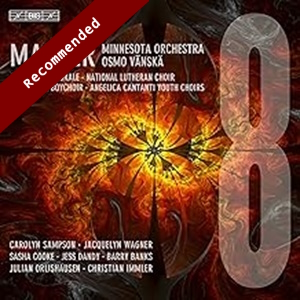
Gustav Mahler (1860-1911)
Symphony No 8 in E-flat major (1906)
Part I: Veni creator spiritus
Part II: Schlusszene aus Faust II
Minnesota Orchestra/Osmo Vänskä
rec. June 2022, live performance and subsequent studio sessions, Orchestra Hall, Minneapolis, USA
BIS 2496 SACD [83]
This quite simply magnificent recording is a triumph all around. The orchestra are on top form; the soloists are uniformly excellent; and the four choirs, superbly balanced, sing out with impressive effect, whether quietly or in full-throated abandon. The organ part is highly effective all along. The final seconds of the Chorus Mysticus are overwhelming, as the repeated crashing of the large tam-tam adds its unique tones to the glorious ensemble.
I have listened to the performance through a stereo amplifier and speakers on a stereo SACD player. The disc also works on a standard CD player, and on 5.0 surround sound equipment. I can only imagine what sound the latter must produce.
The booklet notes that the singer engaged to sing the Magna Peccatrix role and a soprano role in Part 1 caught Covid two days before the performance. Carolyn Sampson, who had sight-read the role in rehearsals, stood in – in addition to her own part. She sings all that impeccably, soaring beautifully in the Mater Gloriosa towards the end of Part II. The other soloists are excellent. One notices tenor Barry Banks’s striking tone quality. According to his Wikipedia entry, he is a versatile artist, notably in Bel Canto opera. He is not a Heldentenor, but has plenty of power for the role of Doctor Marianus.
The soloists are perfectly balanced as part of the overall large ensemble. Their singing in Part I, either singly or in a group, gives the listener time to appreciate their quality. Part 1 usually has such an effect on me that the calm orchestra introduction to Part II comes as a relief. Those are twelve minutes of Mahler’s orchestral wizardry. Strings are pretty much muted, and woodwinds pass in and out of the texture until, at about four-and-a-half minutes, the full orchestra enters for about two minutes. It then goes back to the musings until the Allegro moderato begins, an orchestral introduction to the chorus disjointedly intoning Waldung, sie schwankt heran (The forest, it sways).
Sections of this hour-long Part II remind me of the later parts of the Second Symphony composed some sixteen years earlier (Blicket auf onwards; Barry Banks is impressive here), and of the children’s chorus of the Third Symphony. Once again, I am struck by the soloists’ vocal excellence, but now that no full chorus or a vocal group dominates more or less continuously, the orchestra has a chance to shine forth – and how excellently they play.
I noted that the ending is apocalyptic. Not everyone will be carried away by the gradual crescendo of the last five or six minutes, but I am exceptionally pleased to be spirited away! To attend the live performance must have been a musical experience to remember and cherish.
Jim Westhead
Previous review by Ralph Moore (January 2024).
Help us financially by purchasing from


Other performers
Carolyn Sampson: Part I Soprano, Part II Magna Peccatrix, Mater Gloriosa
Jacquelyn Wagner: Part I Soprano, Part II Una poenitentium
Sasha Cooke: Part I Alto, Part II Mulier Samaritana
Jess Dandy: Part I Alto, Part II: Maria Aegyptiaca
Barry Banks: Part I Tenor, Part II Doctor Marianus
Julian Orlishausen: Part I Baritone, Part II Pater Ecstaticus
Christian Immler: Part I Bass, Part II Pater Profundus
Minnesota Chorale, Kathy Saltzman Romey (artistic director)
National Lutheran Choir, David Cherwien (artistic director)
Minnesota Boychoir, Mark S. Johnson (artistic director)
Angelica Cantanti Youth Choir, Elizabeth Egger (artistic director)

















